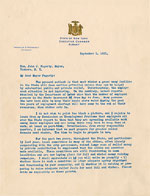Desperate TimesTwo Views of the Stimulus Package that Launched FDR’s New Deal, by Steven Raab and F. S. Naiden |
 |
 |
Plummeting stock prices, rising unemployment, jobs insecure, bank failures, real estate foreclosures: Sound familiar? The year is 1930. That was when Americans began to feel the effects of the economic downturn that began with the Stock Market Crash the previous October, and when a panic mainly limited to investors deepened into the Great Depression.
The realization that this downturn would be long and catastrophic left people stunned and demoralized. Towns of homeless people sprung up, while men who’d held high-paying jobs took to the streets in their once-expensive but now frayed clothing to sell apples and pencils. The Hoover administration took the position that it was not the place of government to intervene. It stood by and did little, which is why the shantytowns were called Hoovervilles.
Through 1930 and into 1931, the problem of unemployment in New York state grew increasingly critical, and it was obvious that neither local funding nor privately supported agencies could handle the crisis. As the leading industrial state, New York had an especial need to maintain and develop the wage-earner market. With the support of both labor and business, Frances Perkins, the state industrial commissioner, told Governor Roosevelt that public works projects were “the greatest source of hope for the future,” and she recommended the immediate implementation of local public works programs along with public employment clearinghouses. He set up an emergency employment committee to review options but was soon convinced that more drastic measures were necessary than the committee proposed.
FDR saw the crisis clearly and assessed it in ways that are relevant for us today. He described where the country was and how it had arrived there to the students of Oglethorpe College, then gave his philosophy on government involvement: “The country needs and, unless I mistake its temper, the country demands bold, persistent experimentation. It is common sense to take a method and try it: If it fails, admit it frankly and try another. But above all, try something. The millions who are in want will not stand by silently forever while the things to satisfy their needs are within easy reach.” Roosevelt’s actions as governor of New York matched this belief.
In January 1931, Roosevelt declared that in order to meet this unprecedented emergency, the state had to look for new solutions to meet new problems. Deploring the “Pollyanna attitude” of the Hoover administration, he called for experimental programs, an innovative tactic that became a hallmark of his social policy during the New Deal years. He also called for legislation that would enable the state to give immediate aid to unemployed New Yorkers.
On August 28, 1931, in a landmark speech to a special emergency session of the state legislature, FDR advocated creation of a government agency to undertake relief and public works. On September 23, the legislature authorized the Temporary Emergency Relief Administration (TERA) which was the first agency of its kind in the nation. Roosevelt named Harry Hopkins, later his senior aide as president, to run the new agency. TERA immediately targeted emergency relief for the unemployed. Able-bodied workers without jobs would get aid from the state—first home (direct) relief and then the more desirable work relief. Roosevelt thus set a precedent by creating a new agency to meet a new problem, one he relied on during the New Deal years.
FDR assessed the crisis in ways that are relevant for us today.
In the immediate wake of his address to the legislature, FDR wrote to mayors of the state’s largest cities, to pledge that he would act to fight the Depression, to detail his plans to create jobs, to stimulate local and private aid, and to make sure that the cities were prepared for what he saw as a time fraught with desperation for large numbers of people:
“The present outlook is that next winter a great many families in the State will face serious privation unless they can be helped by substantial public and private relief…For my part, as Governor of the State, I intend to help in every way in my power…Now is the time to begin to make preparations…”
The success of the New York program catapulted FDR to national attention, and the innovative solutions and fresh thinking he brought to bear at a time of deep crisis appealed to the nation. He was easily nominated for president less than a year after TERA commenced operations; soon he would have the opportunity to try his hand at battling the Great Depression as President of the United States.







